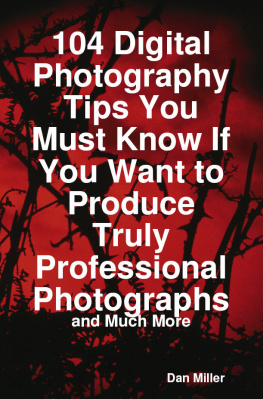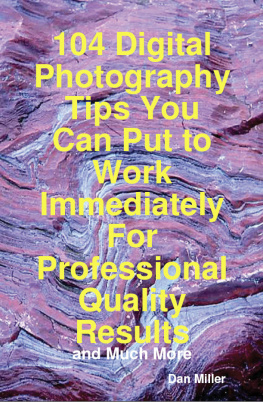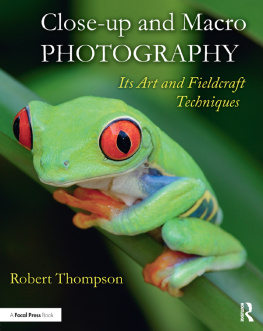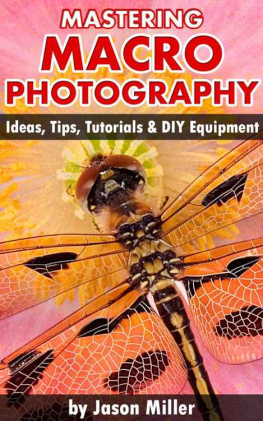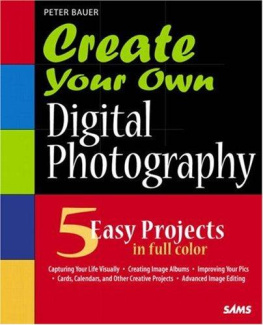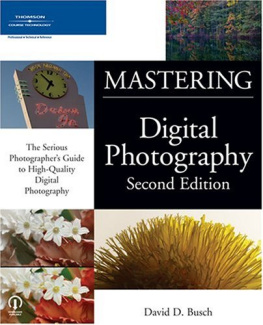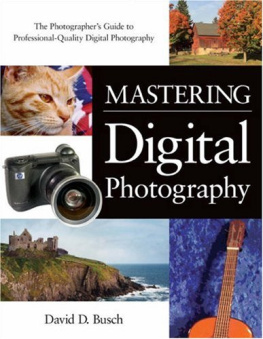About This Book

All roads lead to Rome, only in this case its the petals of this magnolia blossom pulling us to the center. Focus on the center and let everything else go soft. Blossom was placed slightly off center in the frame.
Canon 1Ds Mark II with 180mm f3.5 L macro lens, 1/80 second at f8 +1/3 stop exposure
FOR ANYONE WHO LOVES nature, whether admiring the flowers in a garden, watching a butterfly, or examining natures patterns, the desire to capture these images is as natural as taking the next breath. Macro photography is the visual portal to a world most people walk by without a glance. Plants, animals, and parts of plants and animals never before imagined enter the cameras viewfinder. Best of all, close-up photography does not require trips to Alaska, Africa, or any other exotic locale to capture visually compelling natural images. A walk in the backyard garden or a neighborhood park can provide a wealth of material to photograph close up.
While it may be exciting to think about capturing the image of one petal of a flower or a single dewdrop, or filling the frame with a butterfly sipping nectar, macro photography is intimidating to many photographers. The technical considerations can seem overwhelming. Fortunately, the equipment available today makes macro photography much easier than it was years ago. Its still more dependent upon good technique than normal shooting, but with some work and experience, the photographer of flora and fauna will find that the macro world offers incredible new opportunities.
This book is designed to help macro beginners as well as more advanced photographers develop a practical approach to capturing professional-quality macro images with a minimum of fuss and a maximum of fun. For the beginner, this book will help to establish a solid foundation in the language of macro photography and provide an introduction to the technical considerations. The more advanced photographer will gain a better understanding of how to approach an image under difficult conditions. While some point-and-shoot cameras can capture macro images, the techniques and advice in this book are aimed at users of digital single-lens reflex (DSLR) cameras.
Some macro books go into great technical detail with formulas, charts, and elaborate field setups. While those books are a great source of information, this book presents a less technical and more user-friendly approach to macro photography. It covers macro basics, equipment considerations, field techniques, and digital photography. In each chapter, sidebars provide a more detailed explanation of some technical consideration or point out where or why digital photography requires a different approach from film. Different photographic styles and how they are achieved are explored. Common mistakes that photographers make when first attempting to do close-up work are also mentioned.
In class, students are always interested in the thought process behind different images. They want to know what attracted me to the image, why I chose a particular angle, what I left out, and what f-stop I used and why. For this reason, I have included five case studies that reveal my thought process.
While digital photography certainly involves the computer, this book does not go into great detail on computers and software. The intent is to give you an understanding of macro photography that will endure regardless of advances in computer and software technology.
Above all, I hope reading this book enables you to have fun capturing your very own macro imagesnot the images or style of any other photographer, professional or amateur, but images that represent your vision, images that put a smile on your face each time you view them.
Acknowledgments

The soft sunlight on the center of this shrub rose presented a What could it be? feeling when in this close. Even if I set the aperture at f22, parts of the image would be out of focus. I elected to use a medium aperture and focus on the anthers.
Canon 1Ds Mark II with 180mm f3.5 L macro lens, 1/40 second at f11
I AM FREQUENTLY ASKED how and why I became a photographer. The why is a combination of family history, the desire to create, and a love of nature.
My grandfather, Christian Detrick, was a freelance photojournalist before newspapers had staff photographers. In 1934, he decided to go to Lakewood, New Jersey, to shoot the arrival of the Hindenburg. His assistant could not go so he enlisted the help of my uncle, Leonard Detrick. The one-day shoot became a three-day outing when the dirigible burst into flames and crashed at the landing site. Immediately upon returning to his regular job, Leonard was fired. However, his boss kindly told him he thought he would make a fine photographer. Leonard ultimately became one of the lead photographers for the New York City Daily News.
While I always knew that part of the family history, it was not until a conversation with my mother a few years before her death that I discovered her great-grandfather owned and ran a large nursery in Germany in the 1800s that remained in the family until recently. At that point, it seemed obvious that I was destined not only to be a photographer but also to be drawn to photograph horticultural subjects and gardens.
The how I became a professional photographer is somewhat different. When our daughter graduated from college, my wife, Linda, suggested we try to turn my love of photography into a business. I would do the photography and Linda would handle the marketing and contracts. The combination of a business background, lots of research, long days of predawn-until-dusk shoots, and a lot of luck produced results. In a few short years, we noticed that the major portion of our business involved gardening, and that became where we focused.
Over the years, I continually took photography workshops with exceptional photographers including John Paul Caponigro, Dick Frank, Arthur Meyerson, Seth Resnick, John Shaw, and Larry West. Each one of them in their own way exerted a positive influence on my photography. To this day, I try to learn from photographers who offer a different way of looking at or thinking about a subject.
Fellow garden photographers also influence my work. My good friend Roger Foley generously and unselfishly shares his expertise on working with light in a garden. Ian Adams, author of The Art of Garden Photography and techno-expert, encouraged me to write this book and consistently keeps me updated on the latest and greatest. Friend and successful garden writer Ellen Spector Platt continually provides sage and meaningful advice on the process of writing a book. The transatlantic couple judiwhite and Graham Rice have been treasured friends and valuable sounding boards for many years.
Thanks also to Peter Kaplan for allowing me to tell the story of Libert mon Amour, and to Canon, Nikon, and Sigma for graciously providing macro equipment for the photographs.
I would like to say a special thank you to all the students who attended my workshops. Their participation allowed me to better understand not only the problem areas in macro photography but the goals as well. I hope this book addresses most if not all of their concerns.
I would be remiss if I didnt mention my editor, Lorraine Anderson. Her patience, understanding, and eye for details, along with the encouragement of Tom Fischer and the rest of the Timber staff, made this project a reality.


